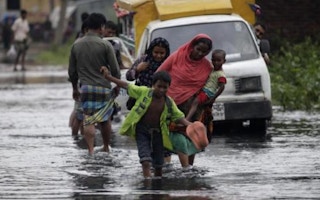Cities are on the front-line of climate change. Journalists have important roles to play in ensuring that cities make the most of finance to strengthen the resilience of vulnerable citizens and infrastructure.
Their media reports can help ensure that these funds become available. They can also shine a spotlight on how the funds are managed to ensure they are spent in ways that deliver substantial improvements to current living conditions and build resilience to future changes in the climate. Step one will be to get to grips with the problem and the kinds of finance available.
The large and growing urban populations of Africa and Asia frequently live in places that are exposed to hazards, such as floods and tropical storms, which will become more frequent and intense in the coming decades. Many towns and cities lack the necessary basic infrastructure and resources to reduce the risk that such hazards pose.
Global discussions about finance to address this challenge seem far removed from this reality. The total amounts pledged by governments through the UN Framework Convention on Climate Change have not been generated – and even if they were, there are few pathways to transfer the funds to local or municipal governments.
“
Few urban residents are aware of the range of funds that their cities could use to build resilience to climate change. Journalists can inform vulnerable citizens about them, so that citizens can in turn make the right demands from their authorities at different scales.
Yet, despite this difficult situation, cities can and do act. A recent assessment of 468 cities worldwide indicated that 68 per cent of them were engaging in the process of climate adaptation planning (PDF). Another survey showed 54 (of 110 cities) were acting to reduce risks from heat waves by planting trees and carrying out other activities, while 30 cities were going a step further by improving their storm water systems to reduce the risk from flooding. Read the summary report (PDF).
Even where funds are tight, there is a range of resources available to city governments to take actions that reduce risks. This variety was evident in a conversation I had earlier this month in Dhaka, Bangladesh with people whose job it is to implement adaptation in more than a dozen cities in Asia and Africa. These city officials identified a number of sources of funding for building urban resilience, which include:
- existing municipal budgets
- special grants from national governments
- public service provider investments, and
- infrastructure loans from development banks.
Some of them argued that using money that is not explicitly labelled as being for climate change adaptation is actually an advantage – as this means that the funds are less subject to shifting priorities and opinions on climate change itself.
A more innovative approach involved handing control of financial resources directly to the communities who are most affected by climate-related shocks and stresses. These locally-managed funds have been pioneered in hundreds of cities in Asia and Africa as a means of giving low-income residents more direct control of their own lives and communities (PDF). Low-income groups have used such funds to acquire land in areas less prone to hazards, such as floods and storms, or to make small improvements to the land to improve drainage and reduce the risk of flooding. These actions directly respond to their own present day needs and build resilience to future threats.
What can journalists do?
Few urban residents are aware of the range of funds that their cities could use to build resilience to climate change. Journalists can inform vulnerable citizens about them, so that citizens can in turn make the right demands from their authorities at different scales. To do this effectively, journalists need to understand the variety of these funding sources, what these can be used for, what their limits are, what else is needed, and what other demands compete for the money. They must not let the apparent small size of the funds, or the fact that they are not labelled specifically for ‘climate adaptation’, blind them to their potential to strengthen people’s resilience to the impacts of climate change, and to improve their lives.
City government activities play a major role in reducing risks for urban residents. But they don’t always have direct access to the funds needed to build resilience. The media and local activists can build campaigns advocating for greater ‘direct access’ to those funds and, when they do become available, they can act as watchdogs to make sure that they are used wisely.
This will entail journalists reporting on projects and activities, asking how and if low-income residents have been involved, and how the impacts will be monitored. But this will also require that both journalists and officials are not being seduced by flashier, visible infrastructure projects that may generate prestige for elected officials, but which often don’t generate meaningful long-term benefits for local communities that often smaller improvements can.
My discussions in Dhaka, and an earlier meeting with experts at IIED discussed in this blog, suggest that both city officials and urban residents often forget about the resources that they have at their disposal.
Journalists can remind them that other options exist, encourage the effective use of the resources, and question the accomplishments that result, making an important contribution to building urban resilience.
David Dodman is a senior researcher on Human Settlements & Climate Change Groups and a team leader on Cities and Climate Change at the International Institute for Environment and Development (IIED). This post originally appeared here.










